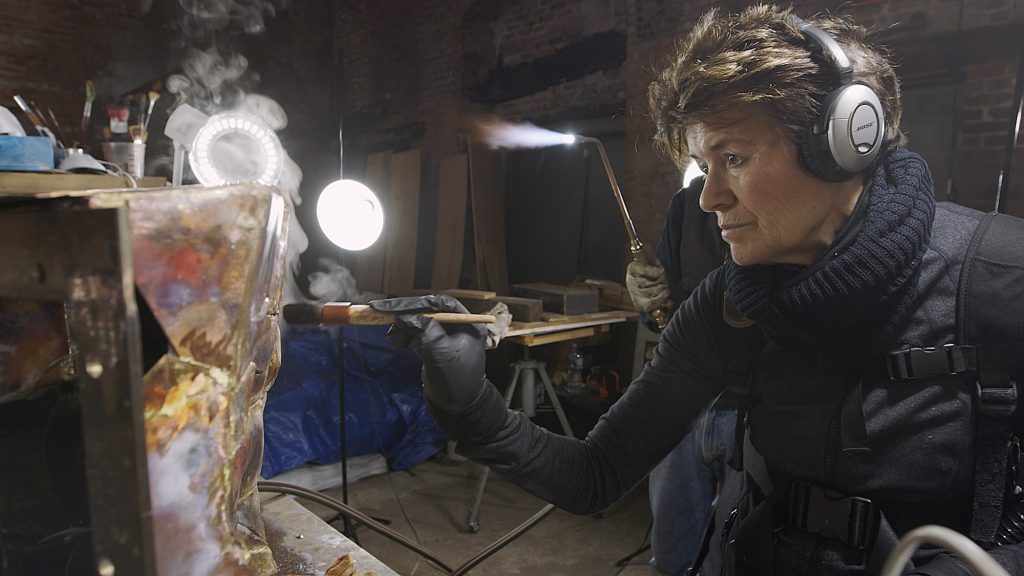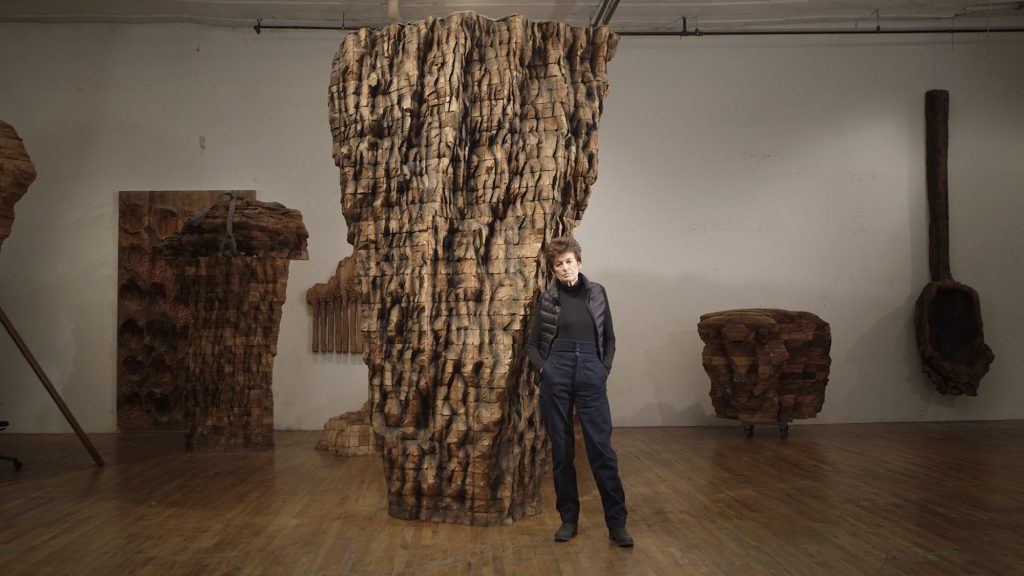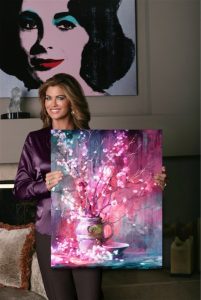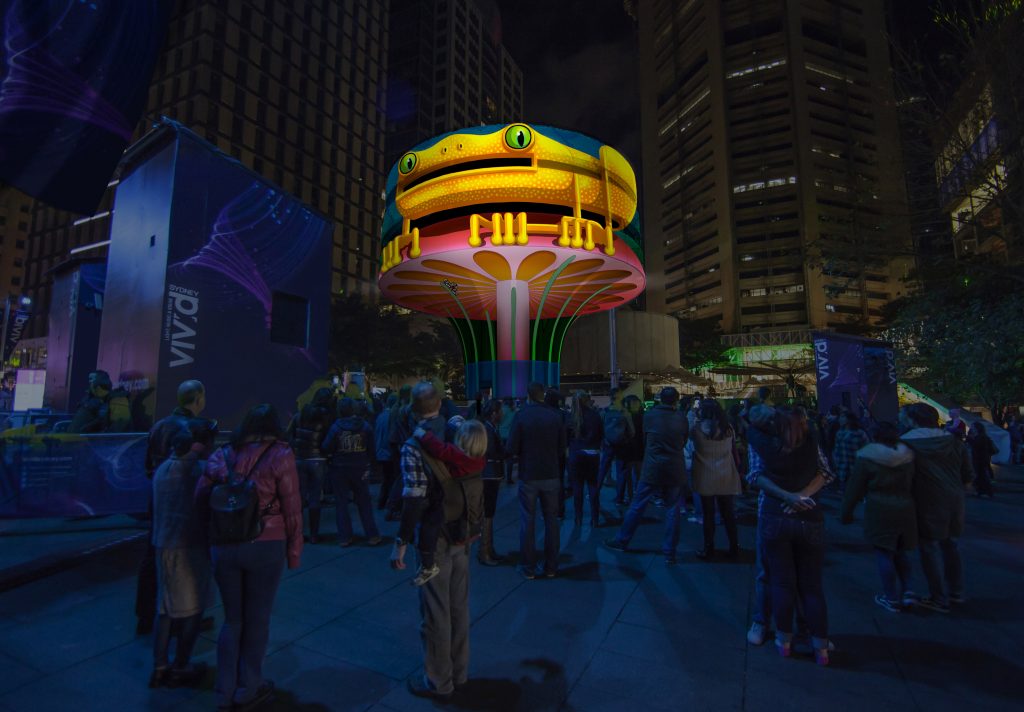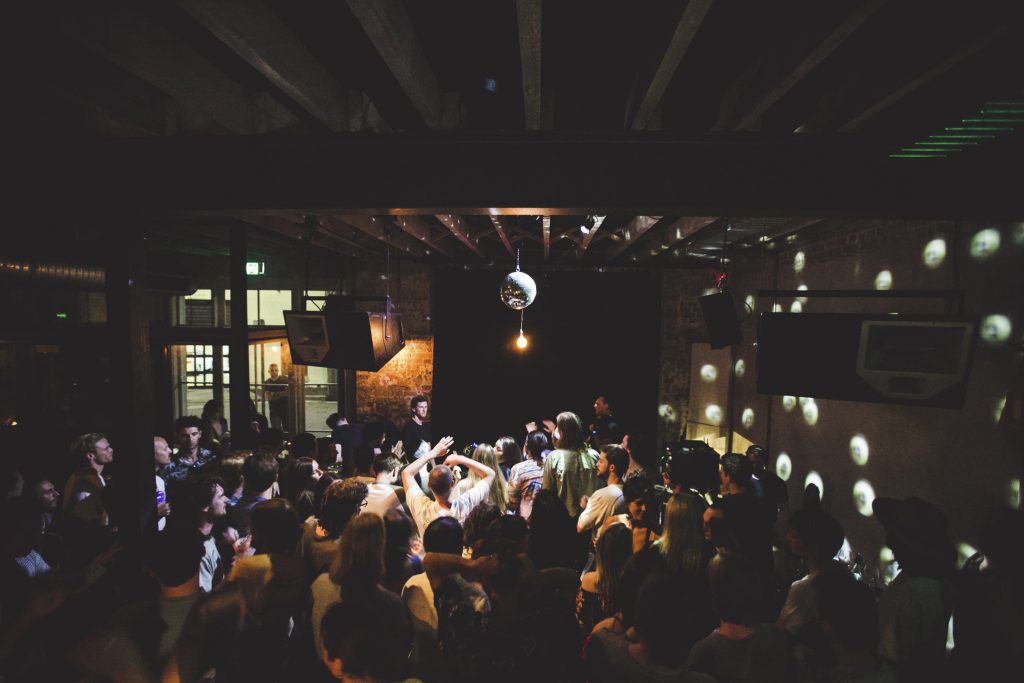August 29, 2020
by Carla Hay
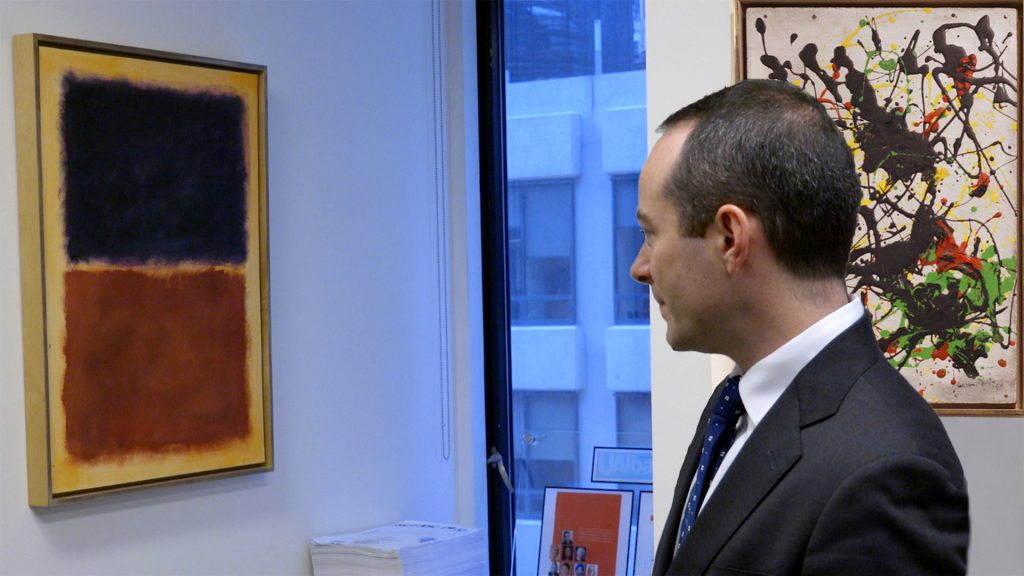
Directed by Daria Price
Culture Representation: The true-crime documentary “Driven to Abstraction” features a predominately white group of people (with a few Asians) discussing the art forgery scandal that shut down Knoedler Gallery in New York City and resulted in lawsuits and criminal prosecution.
Culture Clash: The scandal was an example of how the world of fine art (where one painting can be worth millions) is susceptible to forgeries, with art dealers as knowing or unwitting accomplices to the forgeries.
Culture Audience: “Driven to Abstraction” will mostly appeal to people interested in true-crime stories or the inner workings of the fine-art world.
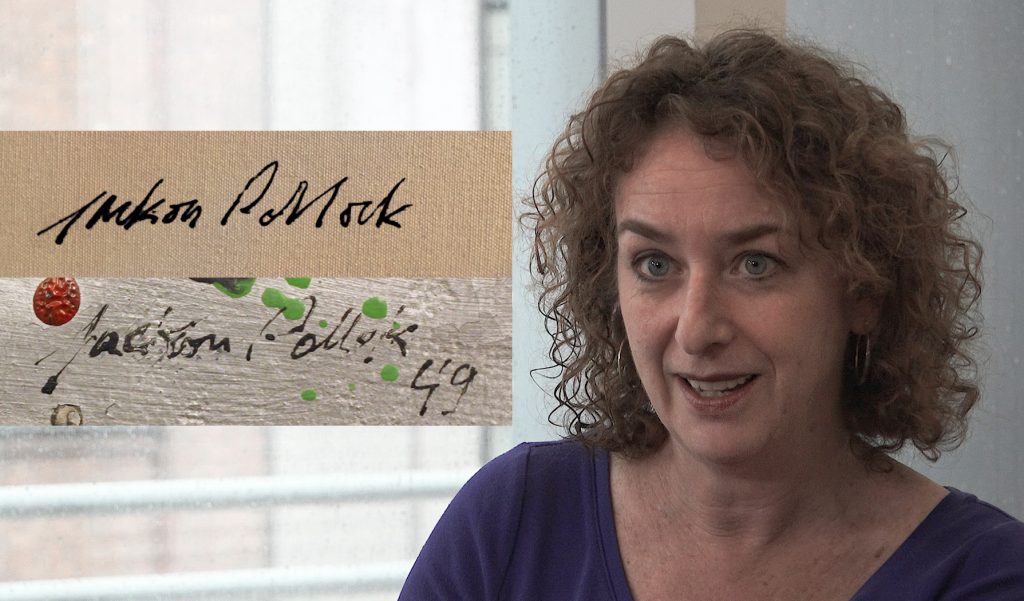
The documentary “Driven to Abstraction” (directed by Daria Price) takes a fascinating look at how greed and the often-secretive world of art dealing collided and exploded into one of the biggest art scandals in history: Knoedler Gallery, which was New York City’s oldest art gallery, was accused of selling about $80 million worth of forged paintings from 1994 to 2009.
The scandal led to the abrupt closure of Knoedler in 2011, after being in business for 165 years. It came out during the investigation that Knoedler had been in serious financial trouble in the final decade before it closed. The money from the forgeries had been keeping the business afloat and was the main reason why the business hadn’t shut down sooner. All of this is such a compelling story that another documentary film has been made about the scandal: director Barry Avrich’s “Made You Look: A True Story About Fake Art,” which has been making the rounds at film festivals in 2020 and is expected to be released in 2021.
One of the people at the center of the scandal was Knoedler’s longtime director Anne Freedman, who was accused of selling 40 forged paintings for about $60 million from 1994 to 2009, the year that she resigned from the company. Freedman received these paintings from an obscure art dealer named Glafira Rosales, who was based on New York’s Long Island. Rosales said she was selling these rare paintings on behalf of a wealthy friend who wished to remain anonymous.
This mystery seller claimed that he inherited the paintings, which were bought by one or both of his parents directly from the artists in the artists’ homes in “top secret” sales. The mystery seller also insisted that the paintings be acquired by private collectors, because it was supposedly his parents’ wish as part of the inheritance. Alfonso Ossorio, who died in 1990 at the age of 74, was a well-known artist from the Philippines, whose name was given as the supposed liaison who gave access to the art world to the mystery seller’s parents, whose names were also kept a secret from buyers.
All of the paintings that Rosales sold to Knoedler were forgeries. The artists whose paintings were forged included Jackson Pollock, Robert Motherwell, Richard Diebenkorn, Andy Warhol, Mark Rothko, Willem de Kooning, Clyfford Still, Franz Kline, Barnett Newman, Lee Krasner and Sam Francis. Jose Carlos Bergantiños Diaz, the live-in boyfriend of Rosales, would be exposed as the ringleader for the forgeries, according to law enforcement.
Why did these forgery sales go on for so long? And who was creating these forged paintings? The forgeries turned out to be work of Pei-Shen Qian, a Chinese immigrant/former art student who had been in the United States since the early 1980s. At the time of the forgery sales, Qian was living in the New York City borough of Queens, where he created all of the forged paintings in his home.
As news reports, court documents and this documentary point out, there were many red flags that could have prevented these forgery sales from continuing as long as they did. For starters, the story kept changing about the mystery seller. Rosales and Freedman told different people different things about this mystery seller.
The contradictions included that the mystery seller’s country of origin was either the Philippines or Mexico and that he was living in Mexico or Switzerland. One story was that he got the paintings as an inheritance from both of his parents, who were actively involved in buying the paintings directly from the artists. In another story, it was only the father, not the mother, who had anything to do with the paintings.
And even the story kept changing about why this seller wanted to remain anonymous. People heard that the seller wanted to keep his family’s financial situation private. But another story was that the seller’s father had a closeted gay lifestyle that was connected to Ossorio, and the seller didn’t want this secret to be revealed to the public. Ossorio’s longtime partner Ted Dragon, who was still alive when the paintings were sold, was one of the people who sounded an unheeded alarm that the paintings were fake and that the “mystery seller” was lying about Ossorio being connected to the seller’s father.
Another big warning sign that the paintings were fake was that there had been no previous record of these paintings ever existing before. Most of these famous artists kept meticulous records and documentation of their work and had people who’d seen these paintings, even if these paintings were sold directly to a private collector. To suddenly have a large collection of these “lost, never-seen-before” paintings emerging in the possession of one person was very suspicious, to say the least.
However, Freedman was able to convince people that the paintings were real by providing lists of known art experts who vouched for the paintings’ authenticity. Apparently, none of the duped buyers seemed to have checked with the experts themselves before buying these paintings. If they had, they would have found out that the people on Freedman’s lists had only casually looked at the paintings in Freedman’s office but hadn’t authenticated them. Freedman put their names on the list anyway, allegedly without their knowledge or permission. And the buyers trusted Freedman because of her exalted and influential position in the art world.
The scam got exposed as buyers who purchased the forgeries would get them tested by art forensics experts and find things such as a Pollock painting that would have a certain type of paint that wasn’t invented until 1970, which was years after Pollock died in 1956. Another Pollock forgery sold by Knoedler had Pollock’s signature misspelled on the painting. Imagine the embarrassment that these buyers felt that they didn’t have these things checked out before they forked over millions for these paintings.
Patricia Cohen, the journalist who broke the story for The New York Times, says in the documentary: “If it hadn’t been for Jack Flam [president/CEO] of the Dedalus Foundation, none of this scandal would have come to light.” The foundation was launched by Motherwell, who kept such detailed records of his own work that Flam knew immediately that the suspicious Motherwell paintings being sold by Knoedler were forgeries. Flam sounded the alarm, which set off a chain of events leading to buyers taking closer looks at the paintings they purchased from Knoedler.
Not surprisingly, Freedman and all the other defendants who faced lawsuits or criminal charges in this scandal are not interviewed in the documentary. Billionaire couple Domenico and Eleanore De Sole’s lawsuit against Freedman and Knoedler (whose owner Michael Hammer was a defendant) went to trial. One of the centerpieces of the lawsuit was that Domenico De Sole—a chairman of Tom Ford International and Sotheby’s and a former president/CEO of the Gucci Group—had unknowingly purchased a fake Rothko painting in 2004 for $8 million from Knoedler, which refused to give him a refund when he discovered it was a forgery.
Although cameras were not allowed in the courtroom, the documentary includes a few courtroom illustrations, as well as brief video clips of Freedman, Hammer and the De Soles outside the courtroom. The plaintiffs and defendants make no comments in these archival video clips, but Freedman’s attorney and the De Soles’ attorneys who were involved in the trial are interviewed in the documentary. Even though the outcomes of these cases have been widely reported, they won’t be revealed in this review, in case people who see “Driven to Abstraction” want to find out what the outcomes were by seeing the documentary.
However, it’s enough to say that Freedman has maintained all along that she did not knowingly sell forgeries. It’s a denial that many people interviewed in the documentary say they find hard to believe, given that these paintings seemed to come from out of nowhere and there were no records that they had existed before this “mystery seller” wanted to unload these paintings. Freedman also fell under suspicion for being part of the scam because she purchased these paintings from Rosales for well below what would have been the paintings’ market value.
The documentary’s production notes have a director’s statement, in which Price comments: “Attending the De Sole v Freedman/Knoedler trial, I met all the players and later interviewed witnesses who were willing to go public. But I also encountered the same reluctance to go on the record that the trial itself exposed—the very same silence that allowed this scam to continue for 15 years. While there are brave insiders, like art consultant and witness Martha Parrish, willing to spill the beans in this film, there are others for whom legal or just plain embarrassing predicaments inhibited their participation.”
However, “Driven to Abstraction” does round up a good range of people from the art world to interview for a lot of insightful perspectives. Parrish, a former board member of the Art Dealers Association of America, comments on the forgeries and why any legitimate art expert should have suspected from the beginning that these paintings were fake: “There were no reproductions in any books. There were no exhibition records. There were no records with any of the dealers that represented those artists. There were no shipping receipts to show how these works … got back to the United States. There was nothing.”
In addition to The New York Times’ Cohen, the documentary’s interviewees include several journalists, such as The Art Newspaper’s Laura Gilbert; ArtNet senior market editor Eileen Kinsella; Vanity Fair contributing editor Michael Shnayerson; Art and Auction and Robb Report writer Judd Tully; art critic/author Blake Gopnik; The Art Newspaper writer Bill Glass; and M.H. Miller of The New York Times and formerly of Art News Magazine.
Hongtu Zhang and Andy Chen—two artists and former friends of forger Qian—are interviewed in the documentary and offer some insight into why he turned to a life of crime. Zhang attended the Art Students League (an art school in New York City) with Qian in the early 1980s. He says that Qian was very talented and thought his art education would lead to professional opportunities, but Qian became frustrated and disillusioned when he found it difficult to make a living as an artist. At one point, Qian (who is described as quiet and introverted) was selling his art on the street for very little money.
Chen says he noticed that Qian became more content over time when Qian’s financial situation improved enough that he was able to buy a house. Qian told people, including Chen, that a gallery was paying for his artwork. In essence, that was true. But what Qian left out of those stories was that his art that the gallery was buying were all forged paintings.
The documentary also mentions that after the scam was exposed, Qian claimed that he was making commissioned “tribute” paintings and wasn’t aware that it was illegal. “Tribute art” is common in Chinese culture. However, it’s pointed out that because the artist’s signatures were being forged on paintings, those forged signatures crossed a line into illegal territory. And because Qian received his art education in the U.S., it would be hard for him to convince people that he was a naïve Chinese immigrant who didn’t know that what he was doing was illegal.
Several people in the documentary marvel at how closely Qian was able to convincingly replicate the styles of so many diverse artists. Ironically, the forger who made it possible for these fake paintings to be sold for millions per painting was the one who got paid the least out of all the people accused of being involved in the scam. Qian reportedly got paid only a few thousand dollars per painting. It was only after the scammers got busted that he found out what his forgeries had been sold for, and Qian was reportedly very shocked.
The documentary’s interviews include several experts in art deals, such as art dealer/art advisor James Kelly, provenance researcher Victoria Sears Goldman, gallerist Doug Walla and Center for Art Law founder Irina Tarsis. Kelly had recommended that the De Soles buy the Rothko painting that turned out to be a forgery and the center of the De Soles’ lawsuit. In the documentary, Kelly admits he was fooled because Freedman showed him a list of known art experts whom she said had authenticated the painting. “Nothing really struck me that it was not an authentic painting,” Kelly comments in retrospect. “It was a beautiful classic.”
Freedman’s attorney Luke Nikas says about Freedman in the documentary: “Not a single person in the art-dealing world came to her and said to her: ‘These are fakes. You can’t sell them.'” As far as Freedman was concerned, Nikas says, she thought that the paintings from Rosales really were long-lost paintings that had been kept a secret from the public.
De Sole attorneys Emily Reisbaum, Gregory Clarick and Aaron Crowell (who are all interviewed in the documentary) obviously disagree. The say that even if Freedman believed that the paintings were real, she just took Rosales’ word for it, which is highly irresponsible for a gallery director on Freedman’s level. And the amounts she paid Rosales were suspiciously low (in some cases, less than $1 million per painting) for these “rare” art pieces.
The Art Newspaper’s Gilbert says that Freedman did get several warnings that the paintings were forgeries but that Freedman was “extremely resistant” to those warnings. Gilbert got the first exclusive interview with Freedman after Freedman’s trial. Gilbert says that Freedman insisted that the interview (which was published in April 2016) be a conversation instead a rehash of the trial. Gilbert describes Freedman having this attitude about the accusations against her: “It’s the art world. Get over it. I didn’t slay anyone’s first-born.”
Art forensic specialist Jeffrey Taylor gives his opinion in the documentary on why Freedman sold forgeries for so many years, regardless of whether or not she knew they were forgeries at the time of the sales: “Hubris is a good word. She began to believe in her own infallibility. Before her fall, she really was the queen bee of the art world.”
When it comes buying and selling fine art, the real price isn’t the market value but rather what someone is willing to pay for it. Anonymous buyers and sellers are not unusual. The business of art dealing at the highest level is fueled by the possibility that wealthy buyers will pay above and beyond what would be considered a reasonable asking price—and it’s the same reason why the business is so susceptible to forgeries. Cohen sums it up in the documentary by saying of the Knoedler scandal: “To pull off a forgery like this, it takes a village … The art world lacks transparency.”
“Driven to Abstraction” director Price also wrote and edited this documentary, which does a very good job of bringing the story together in a cohesive and engaging style. The main area where the documentary needed improving is the sound mixing, which is at times very uneven. However, you don’t have to be an art collector or a fan of these painters to enjoy this movie, because the documentary shows the pitfalls of being dazzled by a famous name and assuming that the name automatically equals authenticity.
Grasshopper Film released “Driven to Abstraction” in select U.S. virtual cinemas on August 28, 2020.

